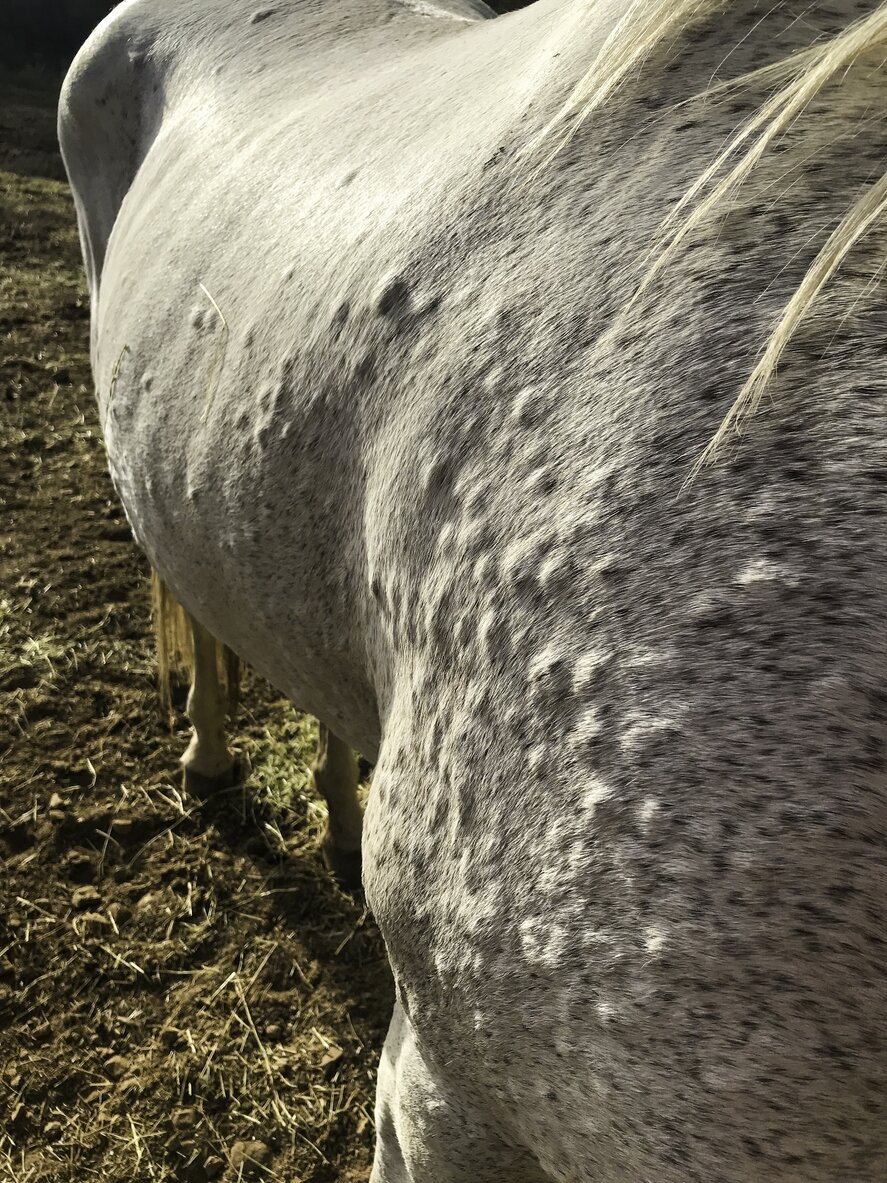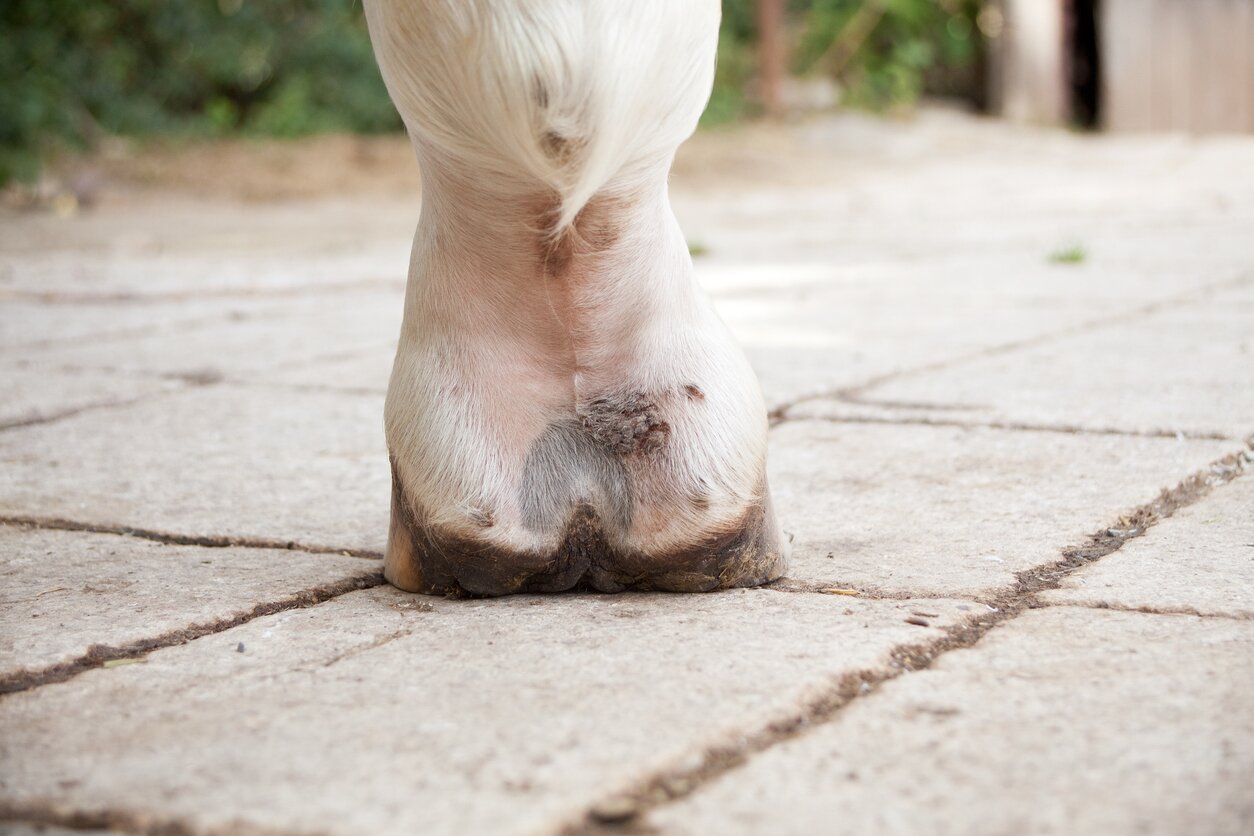Last Updated: 04/06/2025
Common Skin Problems Horses
Wondering which of the most common skin conditions might be plaguing your horses? Read more about these skin conditions and treatment from our vet team.
Author: Dr Teagan Lever BVSc (Hons)
Reading Time: 20 minutes - medium read
Is your horse's coat looking more crusty and scurfy than sleek and shiny? Skin disease in horses can be caused by numerous culprits and treatment is not always straightforward. We've put together some information on a few common causes of skin and coat problems in Australian horses, to help you restore your horse's coat back to its lustrous, gleaming glory.
Remember that this advice is designed to be used as a guide only and you should always consult your veterinarian for treatment advice specific to your horse.
In this article
Queensland itch

Also known as insect bite hypersensitivity, Queensland itch is a common cause of itchy skin in horses all around Australia, not just in Queensland. This extremely itchy condition is caused by the horse's immune system mounting an allergic response to insect bites, chiefly Culicoides species ('midges' or 'no see ums'), but also other biting insects including stable flies and black flies.
Typically Queensland itch first appears in horses around three years of age and is generally noticed by horse owners as intense itchiness resulting in rubbing, loss of hair and thickening of the skin across the topline and centre of the tail base and neck. These poor horses are literally tearing themselves apart! Generally symptoms are seasonal as the offending insects tend to be more active during the warmer, wetter times of the year. Symptoms may last for longer periods or even year round in tropical areas.
Queensland itch prevention tips
If your horse is affected by Queensland Itch, taking steps to minimise their exposure to the biting insects causing the reaction is the first place to start.
- Use insect repellent sprays: always check the label to ensure product effectiveness and safety. Some may need to be applied up to twice daily to be effective but can be used on specific target areas as needed.
- Pour on insect repellents applied to the horse's topline are often longer lasting and can be a better alternative for horses who don't like being sprayed.
- Provide physical protection from bites with rugs and hoods, particularly at peak biting times during dawn and dusk.
- For stabled horses, consider using strong fans to deter midges and screen windows with fine mesh where possible.
- Remove potential midge breeding sites such as stagnant water, manure and decaying vegetation from your horse's environment.
If you're unable to keep your horse with Queensland itch comfortable after trying the tips above, a check up with your local equine veterinarian is essential. They'll be able to confirm the diagnosis and provide short term treatment for the symptoms, as well as advice for long term prevention and management.
Greasy Heel

An often frustrating condition to manage, greasy heel, also known as pastern dermatitis, is an inflammation of the skin of the pastern, which can be caused by a number of conditions including bacterial or fungal infections, mite infestations and contact irritants (including some plants or topical medications).
Treating greasy heel in horses
In order to effectively treat greasy heel, it is recommended to seek advice from your veterinarian to diagnose the underlying cause of the problem. Your vet may be able to examine smears or scrapings from the lesions under a microscope to reach a diagnosis, or in some cases they may need to take a skin biopsy for examination by a veterinary pathologist.
Once the underlying cause for the greasy heel is determined, your veterinarian can advise you in the best course of treatment. For mild cases of bacterial or fungal greasy heel, treatment could involve regular application of antibacterial and antifungal wound healing creams.
Rain scald

Rain scald, sometimes called dermatophilosis, is a common bacterial skin infection that loves to pop up in horses, especially when things get a bit wet and humid. It's caused by a bacterium, Dermatophilus congolensis, which just loves to sneak into the skin through tiny scrapes or even insect bites when your horse is constantly damp.
You'll spot it by matted hair, crusts, and scabs, usually along their back, rump, and neck. When these scabs come off, you might see raw skin underneath, sometimes even with a bit of pus. It can look a bit like "paint brush" lesions because the hair comes out in clumps. While it's generally not life threatening, rain scald can be pretty uncomfortable for your horse, and in some serious cases, it could even lead to other infections.
Keeping rain scald at bay
The best way to avoid rain scald is to keep your horse as dry as possible and maintain good skin hygiene. Think about giving them a good shelter, like a stable or a shelter shed, for those really soggy days. Regular grooming is super important too, removing dirt and mud allows the skin to breathe and makes it harder for bacteria to set up shop.
If you're using rugs, make sure they're clean, dry, and breathable, because a wet or dirty rug can just trap moisture against their skin and make things worse. Keeping those pesky flies and biting insects under control can also help, as they can create those tiny skin punctures where the bacteria can get in.
Treating rain scald
If your horse does get rain scald, jumping on it quickly is key to stopping it from getting worse. For mild cases, a good wash with an antiseptic shampoo (look for ones with chlorhexidine or povidone-iodine) and then thorough drying is often sufficient. Gently removing any scabs helps the medication reach the skin, but be careful not to irritate it further.
For more severe or widespread cases, your vet might prescribe some special washes or even antibiotics. After treating it, remember to keep up with those preventative measures to stop it from coming back. Regularly checking your horse's skin, especially when the weather's wet, will help you spot any signs early so you can nip it in the bud.
The answer is not always skin deep
While there are a wealth of convenient and effective remedies available to treat a whole range of equine skin maladies, it pays to remember that when it comes to successfully treating skin disease in horses, a diagnosis is key. Many different skin conditions in horses can look the same on the surface with additional diagnostics required to determine the underlying cause. For best results and your horse's health and wellbeing, it is always best to consult your veterinarian for advice prior to embarking on a course of treatment.
Further Reading
Want to read more? Check out our other articles:
What are the best supplements for my horse?
History
Our experts continually monitor the health and wellness space and we update our articles when new information becomes available.
Tue Feb 11 2025
Edited by Dr Teagan Lever BVSc (Hons)Dr Teagan Lever BVSc (Hons)
Head Veterinarian, BVSc (Hons)
Pet Circle's Head Veterinarian, Dr Teagan graduated from the University of Queensland in 2010 and went on to work in small animal and mixed practice in various locations around QLD & ACT before joining Pet Circle in early 2016. Dr Teagan has special interests in dermatology, nutrition and preventative health care. She feels privileged to witness the special bond people share with their pets on a daily basis and enjoys forming lasting relationships with pet parents and their fur children.

